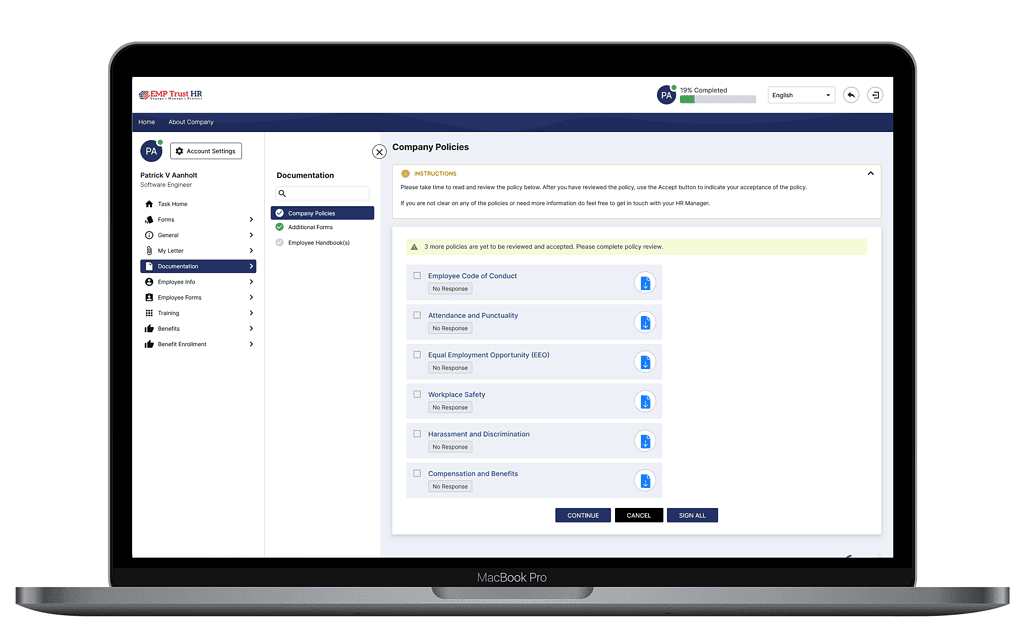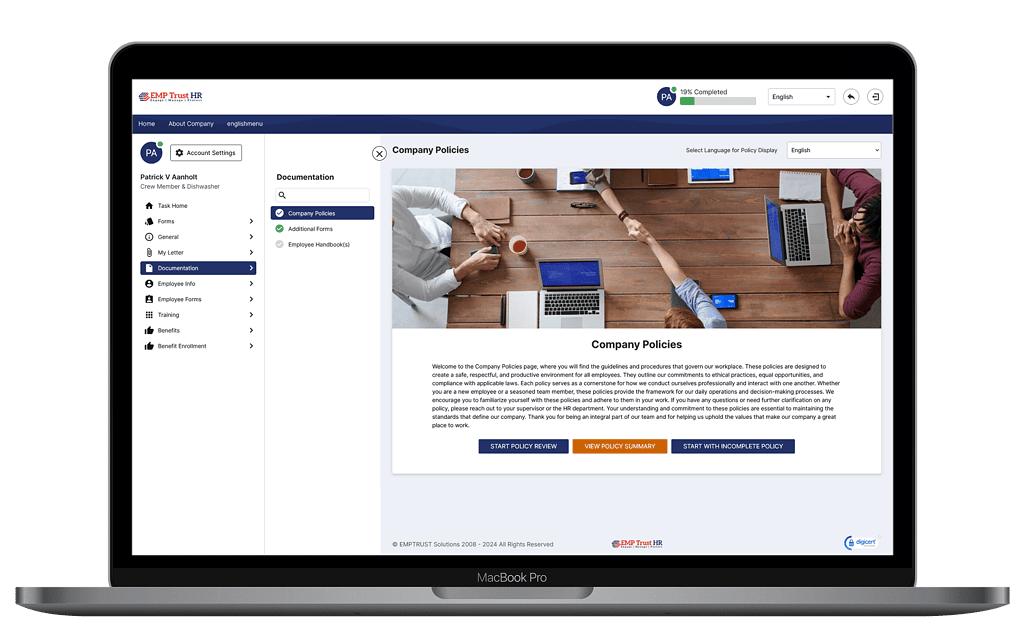It might be tempting to delay the task of drafting your official HR policies and procedures, particularly if you’re running a startup or a small business. You could have other, more urgent matters to address—or perhaps you prefer to maintain a friendly and informal atmosphere with your small team.
However, while fostering trust between employers and employees is crucial, the absence of clear and transparent guidelines will likely lead to misunderstandings over time. Don’t wait for issues to emerge before you formalize your policies. Establish definitive ground rules for your employees, safeguard your rights as the employer, and ensure that your team remains aligned.
Let’s explore the essential HR policies that should be included in your employee handbook.
- What are HR policies and procedures?
- The purpose of human resource policies
- How to formulate an effective HR policy
- 10 HR policies to incorporate into your handbook.
What are HR policies and procedures?
Human resource policies are established rules and guidelines that organizations implement to manage their workforce. In contrast, HR procedures provide detailed, step-by-step instructions that outline the actions needed to adhere to these policies. Creating these policies and procedures is a fundamental responsibility of human resource management.
HR procedures typically take the form of standard operating procedure (SOP) documents. Here’s an example of how a documented HR policy can appear in EMPTrust’s HR Policy Hub, a centralized workspace for all your team’s knowledge, documents, and projects. Sign up and begin documenting your HR policies in one accessible location:
HR policies encompass a wide range of areas within human resource management, including:
- Recruitment
- Dress code
- Overtime compensation
- Vacation
- Sick days and personal leave
- Performance evaluation
- Termination
The Purpose of Human Resource Policies
While some HR policies are mandated by law, there are additional reasons for their necessity. Beyond safeguarding your organization against legal claims, these policies play a crucial role in promoting a culture of trust, fairness, and inclusion.
The advantages of having clear and comprehensive HR policies include:
- Providing legal protection for your company
- Clearly communicating the conditions of employment
- Setting employee expectations regarding career advancement
- Assisting in the resolution of employee grievances and disputes
- Accelerating the decision-making process on various HR matters
- Ensuring that all employees are treated equally and fairly
- Contributing to a safe and healthy work environment
- Serving as a foundation for streamlining and automating HR processes
How to Write an Effective HR Policy
Maintain consistency in the structure and formatting of your HR policies. While each company may have its own internal templates for drafting these policies, the content typically includes the following elements:
- Policy name
- Effective date of the policy (along with dates of any revisions or updates)
- Name of the individual responsible for updating the policy and addressing inquiries about it
- Purpose of the policy
- (Optional) Definitions of specific terminology used in the policy
- Main policy statement
- Scope and applicability (including permissible exceptions)
To be effective and achieve the goals outlined above, HR policies should also be easily searchable and accessible to employees. Publish the HR policies in your employee handbook or on your company intranet portal and ensure that they are shared with the entire team.
10 HR Policies to Include in Your Handbook
The workplace is constantly evolving, and it’s important for your HR policies to keep pace. Yet, not every business allocates time to update its policies and procedures. For instance, a significant 63% of Americans say their employer lacks a social media policy.
The specific policies you’ll need to include in your employee handbook depend on various factors, including the size, location, and industry of your organization, as well as the HRIS software you use and the unique needs of your business. However, several key policies are commonly deemed essential by most organizations:
Code of Conduct
The code of conduct outlines the company’s expectations regarding employee behavior, defining what is acceptable and what is not to maintain a safe and comfortable workplace for everyone. This policy typically covers issues such as:
- Dress code
- Social media use
- Punctuality
- Alcohol and drug use
- Harassment and bullying
Recruitment Policy
The recruitment policy establishes criteria for candidate selection and outlines the onboarding process for new employees. If your organization has an employee referral program, it should also be included in this policy.
Termination Policy
The termination policy describes the proper processes for employee resignations and specifies the notice period required. It may also detail the actions that could lead to termination of employment.
Working Hours and Overtime Policy
This policy should clearly define the flexibility of work hours, break times, and the clock-in and clock-out procedures. Additionally, it should explain how overtime work is managed and compensated.
Attendance and Remote Work Policy
This policy articulates whether employees are expected to work from the office or can work remotely. If remote work is permitted, include pertinent procedures, such as how to request a home office allowance.
Performance Evaluation and Promotion Policy
Performance evaluation policies are established to transparently communicate how employee performance is assessed and rewarded. This policy aims to ensure fairness and can serve as a motivational tool for staff.
Health and Safety Policy
Regardless of the industry, workplace injuries can pose risks. The health and safety policy outlines procedures and responsibilities for all employees to maintain a safe work environment.
Expense Policy
This policy explains how employees should handle expenses incurred during business trips or team events. If employees are expected to pay out of pocket, describe the reimbursable costs and the procedure for reimbursements.
Benefits and Compensation Policy
Employees should be informed about payroll practices and the benefits they will receive. This policy should outline payment frequency and methods, as well as additional benefits like medical coverage, wellness programs, bonuses, and allowances. Consulting with executive compensation experts can help ensure that your compensation packages remain competitive and fair.
Leave Policy
Allowing employees to take time off is essential for their health, happiness, and productivity. Clearly communicate the amount of leave available and the procedures for requesting it. Include specific policies regarding vacation, sick leave, public holidays, parental leave, and other types of absence.
Additional HR policies and procedures may be legally required in your employee handbook, depending on your country and industry. It’s advisable to consult with a legal professional to ensure compliance and that no critical policies have been overlooked.





